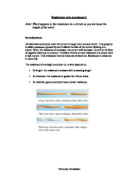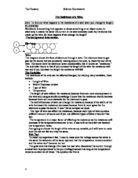Heating elements
Nichrome wire, coiled to take up less space is used to make the heating elements found in many electrical appliances used in houses. Not only does nichrome provide high resistance, it can be kept red hot without oxidising and break in air.
Prediction
In this investigation nichrome wire will be used. Based on the background information it can be predicted that the shorter the length of nichrome wire the less the resistance. Therefore, lengths of 10 cm and 20 cm will provide the least resistance. As the lengths are increased to 30 cm and 40 cm the resistance of the current through the nichrome wire will be affected gradually. Therefore, the flow of electrons will get less and less. Further as the length is increased to 60 cm and thereafter by 10 cm each time up to 100 cm the flow of electrons through the nichrome wire will gradually slow down and become quite reduced. 100 cm length will have the highest resistance in this investigation.
Preliminary Work
Before planning the investigation, it was decided to do some pilot experiments. Therefore, it was also decided to keep the voltage on the power pack to 4v. the current was going to be varied. The nichrome wire was taped to the meter ruler, in order to make the lengths decided to be tested to be more accurate. The lengths tested were 10 cm, 30 cm, 60 cm and 90 cm. the resistance was calculated according to the formula given in the background information:
R = V
I
The results are as follows:
Plan
Based on Preliminary Work
Apparatus and materials to be used in the experiment are as follows:
- Power-pack
- Ammeter
- Nichrome wire
- Meter ruler
- Crocodile clips
- Circuit wire
- Calculator
- Tape
All the above materials will be collected. The nichrome wire will be carefully taped along a meter ruler. The power-pack, the ammeter and the circuit wire will be assembled to make up a simple series circuit as shown in the diagram below. The power-pack will be set to 4v exactly. This will be a constant factor.
The resistance for the 10 cm will be calculated first. Each length will be marked out using a crocodile clip. Once this is completed, the length will increased by another 10 cm to 20 cm. This will continue to 30 cm, 40 cm, 50 cm, 60 cm, 70 cm, 80 cm, 90 cm and 100 cm.
The entire investigation will be repeated at least three times. This will be done to check the results and to make sure that the results are accurate. The current readings in amps will be noted for each length and recorded. The average current after conducting the investigation three times for each length will be worked out. The resistance will be calculated using the formula learnt in the scientific knowledge:
R =
I
All results will be recorded in a suitable table.
Fair test
The same nichrome wire will be used in all experiment, attached to the meter ruler. The same power-pack and ammeter will be used. All lengths tested will be measured out accurately and marked with a crocodile clip each time.
Safety Precautions
Nichrome wire tested at 4V will tend to get very hot. Therefore, it must be left to cool down after a few sets of experiment each time.
All apparatus and materials will be assembled in the work-bench. Stand while doing all experiments. Wash hands after all apparatus and materials are collected at the end of the investigation.
Method
The plan was conducted in the lab. Each experiment was conducted three times and the resistance calculated. The results are recorded in the following table.
Resistance
To show resistance when the length of the wire is varied.
Conclusion
According to the evidence collected in all experiments and the resistance calculated, it can be stated that as the length of nichrome wire tested increase by 10 cm each time, the resistance also gradually increase.
The voltage being kept constant at 4V and the current varied and also the length varied, for 10 cm length of nichrome wire the resistance was 2.70 ohms. When the length was increased to 20 cm the resistance was 5.32 ohms. Each time the length was increased by 10 cm the pattern was that the resistance also increased by approximately 2 ohms or so. Therefore, at a length of 70 cm the resistance was 14.81 ohms and it gradually went up to 22.22 ohms for a length of 100 cm. hence, there are definite trends and patterns in the result obtained.
Whereas the current increased the resistance also increased gradually. In other words longer pieces of wire carry the electrons much more slowly and have a lower resistance. The results prove this i.e. that is for 90 cm of nichrome wire, the resistance was 18.18 ohms. The resistance for the maximum length as mentioned before was the highest- 22.22 ohms.
The evidence gained justifies the prediction made which were based on the scientific information. Shorter lengths of nichrome wire had less resistance and longer lengths took time to carry the electrons and therefore offered greater resistance. All these results are based on the evidence gained under the same conditions in the lab.
Evaluation
All the materials and the apparatus used and the procedure applied which was based on the scientific information researched and the preliminary work conducted was appropriate. Therefore, there was suitable and appropriate results in the evidence gained.
The evidence gained shows trends and patterns. There was a gradual in the resistance each time the length of wire was increased by 10 cm. There were no anomalies in the evidence collected in all the experiment. It followed the pattern in each set of experiment. Therefore, the evidence collected showed to be accurate.
Although the procedure used was accurate, appropriate changes can be made to improve it and get a better idea about resistance and its uses. The lengths of wire can be tested at 5 cm intervals. It must be remembered that if the temperature changes so does the resistance. If a metal wire is warmed up, its resistance goes up. Therefore, the time lapse between experiments should have been longer. It must be ensured that the temperature of the wire is the same in all experiments.
The resistance for each length should have been calculated for each set of experiments, after which the average resistance for each lengths could be calculated after doing it three times. Besides the current could have been kept constant and the voltage varied. The pattern of the result can be compared.
As far as further work is concerned besides testing nichrome wire, other types of wires can also be experimented with e.g. constantine, copper etc. conclusion which time of wire offers the best resistance.
Also wires of different diameters of nichrome, constantine and copper can be tested for quality of resistance.
Test can be done to show the effects of different types of resistors e.g. the resistance of a thermistor can be tested against temperature.
Further and a light dependent resistor LDR can be checked against dark and light situations.
Heating elements made from coils of thin nichrome wire in hair driers, electric kettles etc. can also be looked as learnt in the background information. Variable resistors can also be tested.
Much knowledge has been gained about resistance by doing this investigation. Resistance is used as volume controls in TV’s, radios and in computer joysticks. It is also used in dimmer switches in theatres, living rooms and so on. Practical skills and safety issues has also been learnt. Overall, this investigation has been quite beneficial.
Bibliography
- Co-ordinated science - Physics
By Stephen Pople and Peter Whitehead
- Heinemann co-ordinated science – Higher - Physics
By Graham Dolan, Mike Daffy and Adrian Percival
- Lonsdale Science Revision Guides AQA – Higher







